
Gobiidae is a family of bony fish in the order Gobiiformes, one of the largest fish families comprising more than 2,000 species in more than 200 genera, sometimes referred to as the "true gobies". Most of them are relatively small, typically less than 10 cm (3.9 in) in length. The Gobiidae includes some of the smallest vertebrates in the world, such as Trimmatom nanus and Pandaka pygmaea,Trimmatom nanus are under 1 cm long when fully grown,then Pandaka pygmaea standard length are 9mm (0.35 in),maximum known standard length are 11 mm (0.43 in). Some large gobies can reach over 30 cm (0.98 ft) in length, but that is exceptional. Generally, they are benthic, or bottom-dwellers. Although few are important as food for humans, they are of great significance as prey species for commercially important fish such as cod, haddock, sea bass, and flatfish. Several gobiids are also of interest as aquarium fish, such as the dartfish of the genus Ptereleotris. Phylogenetic relationships of gobiids have been studied using molecular data.
Trimmatom nanus, the midget dwarfgoby, is a species of marine goby native to the Indian Ocean and the western Pacific Ocean. It can mainly be found on oceanic drop-offs at depths of from 20 to 30 metres though it can occasionally be found in outer reef areas and lagoons at depths of from 5 to 35 metres. This species can reach a length of 1 centimetre (0.39 in) SL.

Gobiodon is a genus of gobies also known as coral gobies or "clown gobies". Generally, coral gobies, unlike the rest of the family Gobiidae, are not burrowers, but instead prefer to inhabit the branches of certain Acropora or similar hard corals.
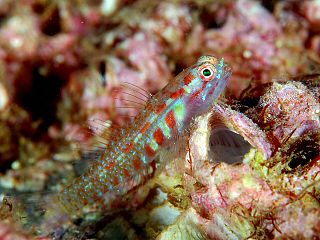
Eviota is a genus of fish in the family Gobiidae, commonly as dwarfgobies found in the Indo-Pacific region, where it is distributed from Japan to Australia and from Africa to Pitcairn Island. Species are mainly associated with coral reefs. Many of these fish are short-lived, with life cycles as brief as 3.5 weeks in the tropics. Some species are hermaphrodites and some representatives live symbiotically among the tentacles of the mushroom coral.
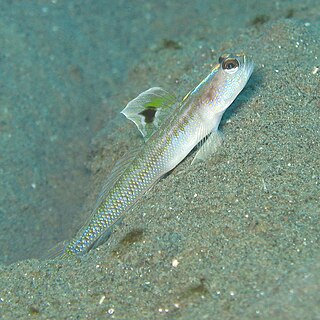
Vanderhorstia is a genus of gobies native to the Indian and Pacific oceans. The name of this genus honours the Dutch biologist Cornelius van der Horst (1889-1951) of the University of The Witwatersrand, Johannesburg, who was well known for his interest in marine biology.
Gobiodon acicularis, the needlespine coral goby, is a species of goby native to the western central Pacific Ocean where it is an inhabitant of tropical coral reefs and eelgrass beds from Indonesia to Palau. It grows to a length of 3.9 centimetres (1.5 in) SL.

True gobies were a subfamily, the Gobiinae, of the goby family Gobiidae, although the 5th edition of the Fishes of the World does not subdivide the Gobiidae into subfamilies. They are found in all oceans and a few rivers and lakes, but most live in warm waters. Altogether, the Gobiinae unite about 1149 described species in 160 genera, and new ones are still being discovered in numbers.

Callogobius is a genus of fish in the family Gobiidae found in brackish and marine waters of the Indian and Pacific Ocean.
Feia is a genus of gobies native to shallow coastal waters of the Indian Ocean and the western Pacific Ocean.
Hetereleotris is a genus of gobies native to the western Indian Ocean and the western Pacific Ocean.
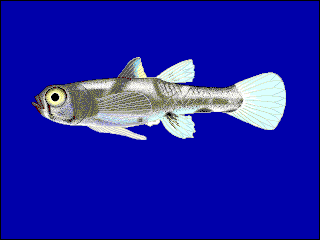
Pandaka is a genus of fish in the goby subfamily, Gobionellinae, native to fresh, brackish and marine waters of Asia and the western Pacific Ocean. Some species in the genus are among the smallest fish in the world; the male P. pygmaea can be just 9 mm (0.35 in) in standard length at maturity.
Sueviota is a genus of fish in the family Gobiidae native to the Indian and Pacific Ocean.

Trimma is a genus of fish in the family Gobiidae native to the Indian and Pacific Ocean. Together with members of the genus Eviota, they are known commonly as pygmygobies or dwarfgobies.

Varicus is a genus of fish in the family Gobiidae, the gobies. They are native to the western Atlantic Ocean.
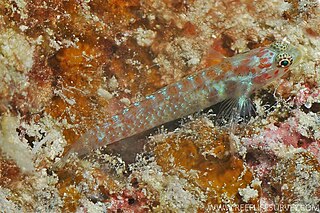
Eviota melasma, commonly called headspot eviota or melasma pygmy goby among various other vernacular names, is a species of marine fish in the family Gobiidae.

Trimma nasa, commonly called the nasal dwarfgoby or nasal pygmy goby, is a species of goby from the Western Pacific. They are small fish, averaging at around 2 cm (0.79 in) in length. They are bright orange and transparent yellow in life, with a white stripe running down from between the eyes to the upper lip and a dark brown spot at the base of the tail fin. They are usually found in large schools in the sloping or vertical drop-offs at coral reef edges.
Trimma tevegae, commonly known as the bluestripe pygmygoby or blue-striped cave goby among other names, is a species of goby from the western Pacific. They are small fish, averaging at 2 cm (0.79 in), orange-brown with white undersides in life, with characteristic iridescent blue or lavender stripes on the sides and on top of the body. They are usually found in large schools in the sloping or vertical drop-offs at coral reef edges. They are sometimes caught for the aquarium trade, and are also known by hobbyists under the name blue line flagtail goby. The species is named in honor of the schooner Te Vega.
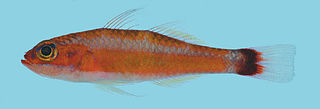
Trimma caudomaculatum, the blotch-tailed pygmygoby , is a species of goby from the Western Pacific. Like other members of the genus, they are usually found in large schools in the sloping or vertical drop-offs at coral reef edges. Similar to other species of Trimma this species consists of multiple cases of bidirectional sex change, meaning that if a group is lacking in a specific sex a partial amount of the group can change their undeveloped gonad structure of the opposite sex in order to accommodate. This sex change is made possible due to the females having a developed set of ovaries with female hormones that are developed, and a set of testis and male hormones that are underdeveloped; The males follow a similar set up in vice versa, so their testis and male hormones are developed, while the ovaries and female hormones are underdeveloped.

Eviota guttata, the spotted dwarfgoby, is a species of ray-finned fish from the family Gobiidae, the "true gobies". It is found in the western Indian Ocean.
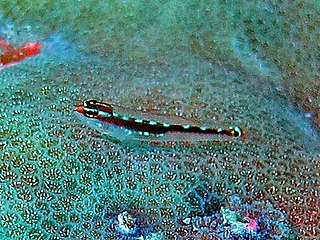
Eviota sebreei, common name Sebree's pygmy goby or striped dwarfgoby, is a species of fishes belonging to the family Gobiidae.













